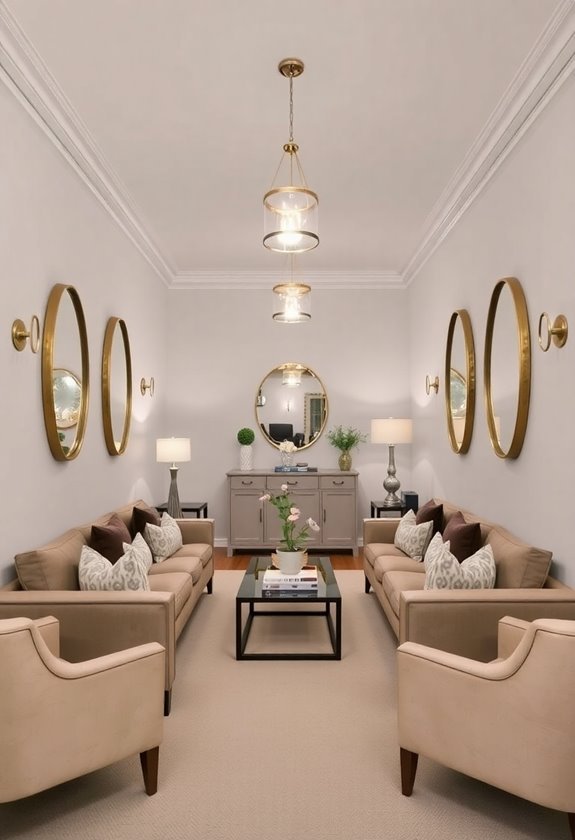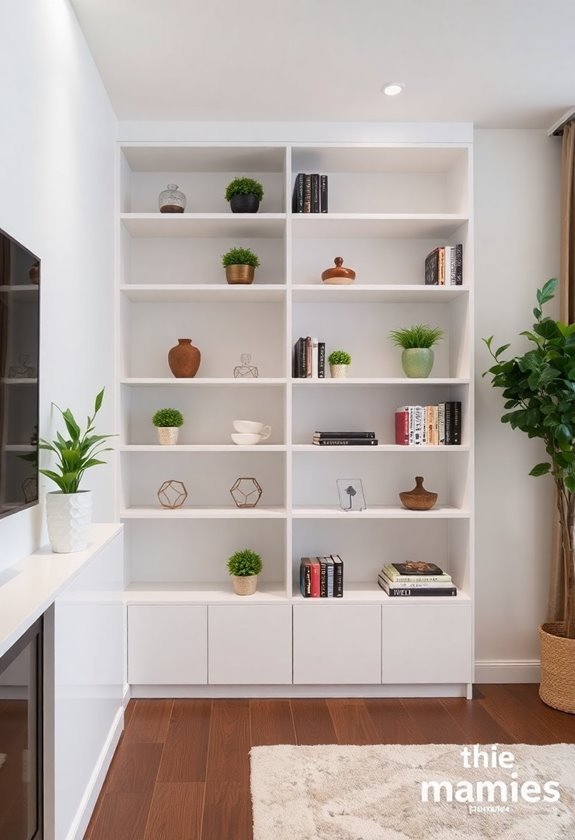Stuck with a bowling alley living room? You're not alone. Long, narrow spaces can feel awkward and tough to decorate, but with the right design tricks, you can transform that challenging layout into a stylish, functional space. Discover practical tips to make your narrow living room feel wider, cozier, and perfectly balanced.
Create Distinct Activity Zones

Three key strategies can transform your long, narrow living room into a well-organized, multifunctional space through distinct activity zones.
Start by laying area rugs to visually separate spaces.
Follow with strategic furniture arrangement using L-shaped sofas and seating groups.
Complete your zones with multifunctional furniture and lighting variations to define each area's purpose while maximizing space efficiency.
Float Your Furniture

Flexibility is the key to maximizing space in a long, narrow living room, and floating your furniture away from the walls can transform the entire layout.
You'll create better traffic flow while defining distinct conversation areas within your space.
Anchor your floating furniture with area rugs to establish separate zones, making your room feel more organized and inviting.
Consider adding minimalist area rugs to maintain a clean, uncluttered aesthetic while still achieving visual separation between spaces.
Maximize Natural Light Flow

Natural light can dramatically transform your living room, making it feel more spacious and welcoming.
Use strategic visual tricks like positioning mirrors opposite windows and choosing sheer window treatments to maximize brightness.
Keep furniture away from windows, and opt for glass or transparent pieces to maintain unobstructed light flow.
Paint your space in lighter colors to reflect natural light throughout the room.
Layer Multiple Lighting Sources

Well-planned lighting layers can transform your living room from a basic space into a versatile haven for various activities.
Start with ambient lighting using ceiling fixtures for overall illumination, then add task lighting near seating areas for reading.
Complete your layered lighting scheme with accent lighting from wall sconces or decorative lamps to highlight artwork and architectural features.
Don't forget dimmers to control the mood.
Use Mirrors Strategically

Illusion becomes reality when you strategically place mirrors in a long, narrow living room.
Position them across from windows to reflect natural light and create an airy feel. Large decorative mirrors serve as striking focal points while expanding your space's perception.
You'll maximize the effect by installing floor-to-ceiling mirrors, and incorporating mirrored furniture adds elegance while visually doubling your room's dimensions.
Choose Space-Saving Modular Furniture

Versatile modular furniture transforms a long, narrow living room into a dynamic space that adapts to your needs.
Space-saving modular furniture offers flexible arrangements that you can easily adjust for different occasions.
Create distinct seating zones with lightweight modular sofas that include built-in storage to keep your space organized.
You'll find these pieces in various styles and colors to match your personal taste.
Sectional sofas provide customizable configurations that maximize seating while maintaining an open flow in narrow rooms.
Define Areas With Rugs

Strategic area rugs bring order and visual harmony to a long, narrow living room.
You'll want to choose rugs at least 8×10 feet to define areas effectively, ensuring furniture legs rest on them.
Layer contrasting rugs to visualize space boundaries between seating areas and walkways.
Opt for lighter colors and subtle patterns to make your room feel more spacious while maintaining clear traffic flow.
Arrange Seating For Conversation

Creating intimate conversations starts with smart seating arrangement. Position your furniture in a U-shape layout, ensuring chairs and sofas face each other.
When arranging furniture, maintain 16-18 inches between pieces for easy movement. Define conversation zones with area rugs, and add flexible seating like swivel chairs to your seating area.
Try angling your furniture layout to make long rooms feel more inviting.
Balance Visual Weight

When designing your living room, balancing visual weight is essential for creating harmony and flow.
You'll want to distribute larger furniture pieces evenly throughout the space while using symmetrical arrangements like matching side tables.
Create zones with strategically placed rugs to anchor your furniture placement.
Consider hanging wall mirrors opposite windows to maximize natural light and create the illusion of more space.
Incorporate varied color schemes with light and dark tones, and add tall accessories to draw the eye upward.
Consider adding stunning side table decorative elements like sculptural vases or artistic objects to create visual interest at different heights.
Incorporate Vertical Storage Solutions

Building upward in your living room opens up endless storage possibilities while maintaining valuable floor space.
Install wall-mounted cabinets and floating shelves to showcase decor while drawing the eye upward. You'll maximize awkward corners with built-in units around doorways and windows.
Add decorative baskets on higher shelves to keep items organized and create visual interest through varying heights.
Add Curved Furniture Elements

Through the strategic placement of curved furniture, you can transform a boxy living room into a flowing, welcoming space.
Consider adding round coffee tables and arched sofas to soften sharp angles and create a cozy atmosphere.
Circular accent chairs and ottomans provide flexible seating while enhancing visual interest.
You'll find that curved elements naturally guide movement throughout the room, making it feel more spacious and inviting.
Establish Clear Traffic Patterns

A well-designed living room demands thoughtful traffic patterns that allow everyone to move freely and comfortably through the space.
Your furniture placement should create clear pathways of 24-36 inches wide, while positioning seating areas to encourage conversation.
Add multi-functional furniture like ottomans along the edges, and use area rugs to define zones without blocking movement through your room.
Position Focal Points Effectively

Every living room needs a strong anchor point that commands attention and shapes the entire space.
Position your TV or fireplace as the focal point to create a natural gathering area.
Arrange furniture at angles to break up the room's linear feel and boost visual interest.
Add wall-mounted shelves or artwork at eye level, and include a statement piece opposite the focal point for ideal layout flow.
Scale Furniture Appropriately

While focal points draw the eye, proper furniture scaling creates harmony in your living room.
In a narrow living room layout, you'll want to choose smaller pieces that won't overwhelm the space. Look for multi-functional furniture like storage ottomans and slim armchairs that complement your room's dimensions.
Select low-profile pieces to maintain visual balance, and use area rugs to define your seating arrangements effectively.
Blend Functional Storage Solutions

Three key strategies can transform your narrow living room into a storage-smart haven.
First, install built-in shelving along walls to maximize vertical space.
Second, choose multifunctional furniture like storage ottomans to serve dual purposes.
Third, combine wall-mounted cabinets with decorative baskets under tables to maintain organization while creating a clean, uncluttered look in your space.
Express Your Personal Style

Ready to make your narrow living room truly yours? Start by selecting unique accessories that tell your story, from vintage finds to handmade pieces.
Create a cohesive color palette that resonates with your style, and layer textures through pillows and throws. Add a cozy touch with traditional Moroccan blankets that bring warmth and authentic charm to your space.
Display personal photographs creatively, and choose multifunctional furniture that reflects your taste while maximizing space efficiency.
Consider adding a Moroccan leather pouf as a versatile accent piece that can serve as both extra seating and a decorative element.
Frequently Asked Questions
How to Furnish a Long and Narrow Living Room?
To furnish a long and narrow living room, you'll want to start with an L-shaped sofa or sectional to maximize seating while maintaining flow.
Add multi-functional furniture like storage ottomans to save space.
Define separate zones using area rugs, and don't forget to incorporate vertical storage with tall bookshelves.
Keep furniture arrangements away from walkways to guarantee easy movement throughout the room.
How Do You Balance a Long, Narrow Room?
You'll want to create distinct zones by arranging furniture in U-shaped or L-shaped configurations that encourage conversation.
Break up the linear feel by placing area rugs strategically to define different functional spaces.
Add vertical elements like tall bookshelves to draw eyes upward, and position larger pieces along longer walls.
Don't forget to incorporate multi-functional furniture like storage ottomans to maximize space while maintaining clear pathways.
How Do You Divide a Long Narrow Living Room?
Like a skilled choreographer directing dancers across a stage, you can orchestrate your space into distinct zones.
Begin by laying area rugs to anchor separate functional areas. You'll want to position furniture strategically – try an L-shaped sofa for the main seating zone and create a cozy reading nook at the opposite end.
Don't forget to use tall bookshelves or decorative screens as natural dividers, keeping the flow open while defining each space.
How to Arrange a Long, Narrow Living Room With a Fireplace?
Position your fireplace as the room's focal point by creating a U-shaped or L-shaped seating arrangement around it.
You'll want to place a sectional sofa along one wall to maximize seating while maintaining clear pathways.
Add a proportionate coffee table 16-18 inches from the seating, and define the space with an area rug.
Don't forget to include wall sconces or floor lamps for layered lighting around the fireplace.


